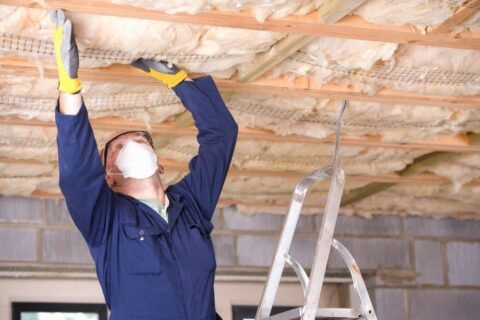Building a deck is a big project with many things to think about. Home improvement shows often make it seem easy, but there are many mistakes to avoid. This article will cover some common mistakes and give tips to avoid them.
From attaching the ledger board wrong to using the wrong fasteners, knowing these issues is key. It helps make your outdoor space beautiful and last long.
Whether you’re experienced or new to DIY projects, knowing these mistakes can save you money. It ensures your deck looks good and lasts long. By following the best practices and paying attention to details, you can make your backyard a safe and fun place for everyone.
Improper Ledger Board Attachment
The ledger board is key in deck building, as it carries half the deck’s weight to the house. If attached wrong, it can cause big problems. Nailing or using lag bolts are not good, as they can’t handle the weight.
Nailing or Using Improper Fasteners
Nails can come loose easily, and lag bolts might not grip solid wood well. Also, modern treated lumber can corrode steel or iron fasteners fast.
Solution: Through Bolts and Proper Flashing
Using through bolts is the best way to attach a ledger board. They go through the ledger, the house, and into the framing. This keeps the ledger board from coming loose. Hold-down anchors are also good, connecting the ledger to joists inside with galvanized rods.
Structural engineers say these methods stop the ledger board from falling. It’s also important to put flashing between the ledger and the house to keep water out.
| Common Fastener | Strength and Durability |
| Nails | Prone to pulling away, insufficient holding power |
| Lag Bolts | May not bite into solid wood, reduced holding power |
| Through Bolts | Strongest connection, penetrate through the structure |
| Specialized Hold-Down Anchors | Highly recommended by structural engineers, prevent detachment |
Incorrect Beam-to-Post Connections
If a deck is raised off the ground, it has a beam supported by posts away from the house. Bad connections between the beam and posts can cause it to fall, leading to deck collapse. A common error is letting the beam just sit on the posts without a strong hold.
Beams Improperly Resting on Posts
Builders sometimes just place the beam on the posts without any extra hold. This is not safe because the beam can move or fall off the posts, causing the deck to collapse. It’s important to have a strong connection between the beam and posts for a safe deck.
Solution: Notched Posts or Approved Connectors
There are two good ways to connect the beam to the posts. One is to cut an L-shaped notch at the top of the posts. This lets the beam sit securely on the ledge. Then, the remaining 2 inches of the post can be bolted to the top of the beam.
The other option is to use special metal connectors. These are made to securely connect the posts and beam. It’s key to make sure the connector fits the lumber size and resists corrosion.
Using either of these methods ensures the beam is safely attached to the posts. This reduces the chance of deck collapse and makes your outdoor space safer and longer-lasting.
Deck Building: Using Improper Decking Fasteners
Choosing the right fasteners for decking is key in deck construction. Many builders use nails, which are fired through wood quickly. But, the nails’ corrosion resistance is very important.
Electroplated Galvanized Nails Prone to Rust
Electroplated galvanized nails rust quickly, especially in wet or coastal areas. This can cause big problems and even deck failure over time.
Solution: Stainless Steel or Hot-Dipped Galvanized Fasteners
The best choice for deck fasteners is stainless steel, known for its strong corrosion resistance. Hot-dipped galvanized fasteners are a good second option, with a thicker, more durable coating. Always follow the decking manufacturer’s advice on fastener type and size to keep the warranty valid.
Adding a special joist tape on top of the joists helps protect against water. It keeps the joists strong and safe.
For homeowners looking to avoid common deck building mistakes, consulting professional deck builders Calgary can help ensure proper ledger attachment, beam connections, and the use of correct fasteners for a safer, longer-lasting deck.
Conclusion
Building a high-quality deck needs careful attention and avoiding common mistakes. It’s important to attach ledger boards correctly and use the right fasteners. This ensures a safe and beautiful outdoor space.
Following best practices and manufacturer guidelines is key. This way, homeowners can enjoy their deck for many years. It becomes a valuable part of their home.
Creating a lasting deck requires focus on detail and working with experts. By avoiding mistakes and using the right solutions, homeowners can enjoy their outdoor space. It becomes a cherished part of their home for years.
FAQ
What are some common deck building mistakes that need to be avoided?
Common mistakes include wrong ledger board attachment and bad beam-to-post connections. Also, using the wrong decking fasteners is a big no-no. Fixing these problems is key to a great outdoor space.
How important is the ledger board attachment, and what are the right solutions?
The ledger board is vital as it carries half the deck’s weight. Using nails or wrong fasteners can cause serious damage. The best way is to use through bolts or hold-down anchors for a secure connection.
What are the proper ways to connect the deck beam to the supporting posts?
Bad connections can make the beam fall off, causing the deck to collapse. To avoid this, cut an L-shaped notch or use metal connectors. These methods ensure the beam stays in place.
What type of fasteners should be used for the deck decking, and why?
The right fasteners are crucial for decking. Don’t use electroplated galvanized nails as they rust quickly. Stainless steel fasteners are best for their corrosion resistance. Hot-dipped galvanized fasteners are a good second choice.

Daniel J. Morgan is the founder of Invidiata Magazine, a premier publication showcasing luxury living, arts, and culture. With a passion for excellence, Daniel has established the magazine as a beacon of sophistication and refinement, captivating discerning audiences worldwide.





